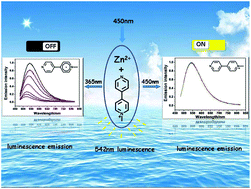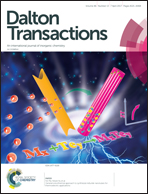Anion-controlled photochromism of two bipyridinium-based coordination polymers and nondestructive luminescence readout†
Abstract
The past ten years have evidenced the rapid development of bipyridinium-based coordination polymers, however, the design and synthesis of photo-switchable luminescent materials with a non-destructive readout capability based on bipyridinium ligands are still at the primary stage. In this work, two new coordination polymers with a bipyridinium-functionalized m-benzenedicarboxyl ligand were synthesized for this purpose. By using anions with different geometries, the molecular linkage and packing structure have been adjusted, and thus allow the two title compounds to exhibit eye-detectable color development with different photoresponsive rates, and distinct luminescence behaviors. Furthermore, compound 2 is the first reported Zn-based luminescent coordination polymer with a non-destructive readout capability. These results can not only help to further understand the structure–photosensitivity relationships of bipyridinium-based systems but also guide the design and synthesis of more luminescent materials with a non-destructive readout capability.



 Please wait while we load your content...
Please wait while we load your content...